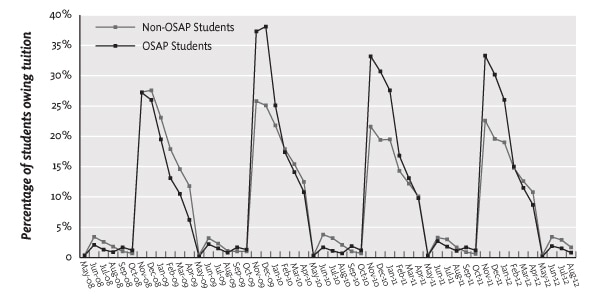Last year, the University of Toronto collected a little over $1.75 million in tuition interest fees from undergraduate students at the St. George campus. Benjamin Coleman, an arts & science at-large director of the University of Toronto Student’s Union (UTSU) revealed the information Tuesday, following a freedom of information request submitted to the university.
According to Coleman, the current deadline for paying tuition is too early, which leads students to accumulate interest charges at high rates. A major cause for concern, he claims, is that “you can save money by going to a bank if you have unpaid tuition.” Students pay 19.56 per cent interest annually to the university. The five major Canadian banks advertise basic credit card plans at 19.99 per cent annual interest. In contrast, RBC’s student line of credit is four per cent annually. Other major banks have comparable rates.
As expected, the data shows a large spike in the number of students owing money in mid-November — the university’s payment deadline. There is a steep decrease in January for students receiving financial assistance from OSAP. More surprising is the amount of non-OSAP-receiving students accruing interest charges. These student’s debt levels, unlike those receiving assistance from the province, gradually decrease until May. Approximately 35 per cent of OSAP students and 25 per cent of non-OSAP students accrued interest in November.
A survey of tuition deadlines and payment policies for other universities in Ontario suggests that the U of T’s payment deadlines are an anomaly. While U of T requires full tuition payment before November 15, institutions such as York, Laurier, Guelph, and Ryerson collect their fees in two instalments — once per semester. The University of Western Ontario provides its students with a choice to pay all at once, like U of T, or per term of study.
The UTSU has been lobbying both the administration and the Government of Ontario to institute per-semester billing at U of T says UTSU president Munib Sajjad. Eventually, the union hopes that per-semester billing will be mandated across the province.

The two instalment method is an effective one for students receiving OSAP, as funding becomes available at the beginning of each semester. At U of T, these students are forced to pay interest in the months between November and January, while waiting for the second instalment of funding. Even after January, a subset of these students continue paying interest until May.
Coleman notes that there is another group of students affected by the early deadline: “Those who are able to pay by November but have to put financial strain on their parents, work extra hours, and take out bank loans.”
When asked how the money raised through interest charges is used, the university did not offer specifics. According to Dominic Ali, a spokesperson for U of T: “The funds assist the university in fulfilling its academic mission and providing an outstanding educational experience for students.” As tuition fees constitute a portion of the university’s operating budget, he claims that interest charges are needed to ensure “predictability” of incoming funds; otherwise “It would become challenging for the university to operate and to plan for the future.”
Coleman says insufficient funding is part of the problem, claiming the university is a “partial victim.” While the cost of salaries has gone up over the years, the university has had their funding decreased from both the provincial and federal governments. “There’s a need to get money from students, but having interest charges becomes a problem.” At the same time, “if these things are removed and students are protected, the university will have more financial pressures,” he says.
Last year, the provincial government established a working group comprised of representatives from across the post-secondary education sector, to find a solution for student interest charges. Currently, the deadlines and interest rates are not unregulated by the ministry, and in practice are set at the discretion of each university’s administration. David Raymont, a spokesperson for the ministry, explained that controls around interest fees would be implemented in the coming year. The focus, he says, lies on aligning the timing of payment with OSAP funds release, which does not address the portion of students who pay interest and who do not qualify for OSAP.
In light of these issues, the university is abstaining from taking action, says Coleman. “The university knows there is a problem with students not getting their money on time, but it doesn’t seem like the university understands how it affects their life,” he said.
Ultimately, “The ministry is aware and plans to do things. What needs to happen is that students, and parents, and everyone affected needs to pressure them to follow through,” says Coleman, suggesting those affected write a letter to the Minister of Training, Colleges and Education, Brad Duguid, or join the UTSU in its advocacy for change.

